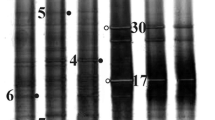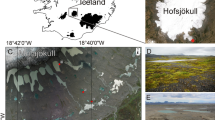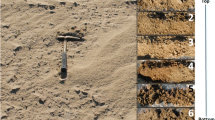Abstract
Seasonal studies of surface sediment bacterial communities, from two basins with differing trophic states within Lake Balaton (Hungary), were carried out using molecular (denaturing gradient gel electrophoresis, DGGE) and cultivation-based techniques. The presence of polyphosphate accumulates was tested using Neisser staining, and phosphatase activity was investigated on organic phosphorus (P) compound. Aerobic viable cell counts were significantly higher in the eutrophic than mesotrophic basin in each season. The lowest viable counts were observed in the autumn and the highest in spring and summer month in both basins. The DGGE fingerprints of the samples reflected that the composition of sediment bacterial communities in the two basins were distinct in spring and summer, and similar in autumn, but similarly diverse in all seasons. On the basis of partial 16S rDNA sequences, the 216 strains were affiliated with six major bacterial lineages: Firmicutes; Actinobacteria, Bacteroidetes, Alphaproteobacteria, Betaproteobacteria, and Gammaproteobacteria. Common species characterized from both basins constituted up to 66% of all identified phylotypes. Strains related to Bacillus sp. were dominant in all but one sample. Isolates affiliated with Aeromonas sp. prevailed in the sample taken from the mesotrophic basin in spring. The majority of the strains showed excess poly-P accumulation. Association of Neisser staining and phosphatase activity test results suggested that excess poly-P accumulation serves as P storage for sediment bacteria. Our study implied the importance of Firmicutes, Actinobacteria, Alphaproteobacteria, and Aeromonas species in benthic bacterial P retention.



Similar content being viewed by others
References
Altschul, S., T. Madden, A. Schaffer, J. Zhang, Z. Zhang, W. Miller & D. Lipman, 1997. Gapped BLAST and PSI-BLAST: a new generation of protein database search programs. Nucleic Acids Research 25: 3389–3402.
Agarwal, A. K. & G. S. Rajwar, 2010. Physico-chemical and microbiological study of Tehri dam reservoir, Garhwal Himalaya, India. Journal of American Science 6: 65–71.
Barak, Y. & J. van Rijn, 2000. Relationship between nitrite reduction and active phosphate uptake in the phosphate-accumulating denitrifier Pseudomonas sp. strain JR 12. Applied and Environmental Microbiology 66: 5236–5240.
Barrow, G. I. & R. K. A. Feltham, 2003. Cowan and Steels’s Manual for the Identification of Medical Bacteria. Cambridge University Press, Cambridge: 235.
Bolier, G., M. C. J. Koningh, J. C. Schmale & M. Donze, 1992. Differential luxury phosphate response of planktonic algae to phosphorus removal. Hydrobiologia 243–244: 113–118.
Borsodi, A. K., A. Rusznyák, P. Molnár, P. Vladár, P. N. M. Reskóné, M. E. Tóth, R. Sipos, G. Gedeon & K. Márialigeti, 2007. Metabolic activity and phylogenetic diversity of reed (Phragmites australis) periphyton bacterial communities in a Hungarian shallow soda lake. Microbial Ecology 53: 612–620.
Chun, J., J. Lee, Y. Jung, M. Kim, S. Kim, B. K. Kim & Y. Lim, 2007. EzTaxon: a web-based tool for the identification of prokaryotes based on 16S ribosomal RNA gene sequences. International Journal of Systematic and Evolutionary Microbiology 57: 2259–2261.
Cole, J. R., B. Chai, R. J. Farris, Q. Wang, A. S. Kulam-Syed-Mohideen, D. M. McGarrell, A. M. Bandela, E. Cardenas, G. M. Garrity & J. M. Tiedje, 2007. The ribosomal database project (RDP-II): introducing myRDP space and quality controlled public data. Nucleic Acids Research 35: 169–172.
Cotner, J. B. & R. G. Wetzel, 1992. Uptake of dissolved inorganic and organic phosphorus compounds by phytoplankton and bacterioplankton. Limnology and Oceanography 37: 232–243.
Davelaar, D., 1993. Ecological significance of bacterial polyphosphate metabolism in sediments. Hydrobiologia 253: 179–192.
Dévai, G., 1990. Ecological background and importance of the change of chironomid fauna, (Diptera: Chironomidae) in shallow Lake Balaton. Hydrobiologia 191: 189–198.
Eixler, S., U. Karsten & U. Selig, 2006. Phosphorus storage in Chlorella vulgaris (Trebouxiophyceae, Chlorophyta) cells and its dependence on phosphate supply. Phycologia 45: 53–60.
Felske, A., A. Wolterink, R. Lis, W. M. Vos & A. D. Akkermans, 1999. Searching for predominant soil bacteria: 16S rDNA cloning versus strain cultivation. FEMS Microbiology Ecology 30: 137–145.
Gächter, R. & J. S. Meyer, 1993. The role of microorganisms in mobilization and fixation of phosphorus in sediments. Hydrobiologia 253: 103–121.
Gächter, R., J. S. Meyer & A. Mares, 1988. Contribution of bacteria to release and fixation of phosphorus in lake sediments. Limnology and Oceanography 33: 1542–1558.
Gloess, S., H.-P. Grossart, M. Allgaier, S. Ratering & M. Hupfer, 2008. Use of laser microdissection for phylogenetic characterization of polyphosphate-accumulating bacteria. Applied and Environmental Microbiology 74: 4231–4235.
Goedkoop, W., K. Gullberg, R. Johnson & I. Ahlgren, 1997. Microbial response of a freshwater benthic community to a simulated diatom sedimentation event: interactive effects of benthic fauna. Microbial Ecology 34: 131–143.
Halpern, M., Y. Senderovich & S. Snir, 2007. Rheinheimera chironomi sp. nov., isolated from a chironomid, (Diptera; Chironomidae) egg mass. International Journal of Systematic and Evolutionary Microbiology 57: 1872–1875.
Herodek, S., 1984. The eutrophication of Lake Balaton: measurements, modeling and management. Verhandlungen der Internationalen Vereinigung für Theoretische und Angewandte Limnologie 22: 1087–1091.
Heyman, J. B., L. M. Eagle, H. A. Greben & D. J. J. Potgieter, 1989. Isolation and characterization of volutin granules as subcellular components involved in biological phosphorous removal. Water Science and Technology 21: 397–408.
Hupfer, M., B. Rübe & P. Schmieder, 2004. Origin and diagenesis of polyphosphate in lake sediments: a 31P-NMR study. Limnology and Oceanography 49: 1–10.
Hupfer, M., S. Gloess & H.-P. Grossart, 2007. Polyphosphate-accumulating microorganisms in aquatic sediments. Aquatic Microbial Ecology 47: 299–311.
Hupfer, M., S. Glöss, P. Schmieder & H.-P. Grossart, 2008. Methods for detection and quantification of polyphosphate and polyphosphate accumulating microorganisms in aquatic sediments. International Review of Hydrobiology 93: 1–30.
Istvánovics, V., 1993. Transformations between organic and inorganic sediment phosphorus in Lake Balaton. Hydrobiologia 253: 193–201.
Istvánovics, V., A. Clement, L. Somlyódy, A. Specziár, L. G. Tóth & J. Padisák, 2007. Updating water quality targets for shallow Lake Balaton, Hungary, recovering from eutrophication. Hydrobiologia 581: 305–318.
Jacobson, L. & M. Halmann, 1982. Polyphosphate metabolism in the blue-green alga Microcystis aeruginosa. Journal of Plankton Research 4: 481–488.
Jenkins, D. & V. Tandoi, 1991. The applied microbiology of enhanced biological phosphate removal-accomplishments and needs. Water Research 25: 1471–1478.
Jenkins, D., M. G. Richard & G. T. Daigger, 2004. Manual on the Causes and Control of Activated Sludge Bulking, Foaming, and Other Solids Separation Problems. IWA Publishing, London.
Jeppesen, E., M. Søndergaard, J. P. Jensen, K. E. Havens, O. Anneville, L. Carvalho, M. F. Coveney, R. Deneke, M. T. Dokulil, B. Foy, D. Gerdeaux, S. E. Hampton, S. Hilt, K. L. Kangur, J. Köhler, E. H. H. R. Lammens, T. L. Lauridsen, M. Manca, M. R. Miracle, B. Moss, P. Nõges, G. Persson, G. Phillips, R. Portielje, S. Romo, C. L. Schelske, D. Straile, I. Tatrai, E. Wille & M. Winder, 2005. Lake responses to reduced nutrient loading—an analysis of contemporary long-term data from 35 case studies. Freshwater Biology 50: 1747–1771.
Jooste, P. J. & C. J. Hugo, 1999. The taxonomy, ecology and cultivation of bacterial genera belonging to the family Flavobacteriaceae. International Journal of Food Microbiology 53: 81–94.
Jørgensen, K. S. & A. S. Pauli, 1995. Polyphosphate accumulation among denitrifying bacteria in activated sludge. Anaerobe 1: 161–168.
Joshi, A., P. Kanekar, A. Kelkar, Y. Shouche, A. Vani, S. Borgave & S. Sarnaik, 2008. Cultivable bacterial diversity of alkaline Lonar Lake, India. Microbial Ecology 55: 163–172.
Kawaharasaki, M., H. Tanaka, T. Kanagawa & K. Nakamura, 1999. In situ identification of polyphosphate-accumulating bacteria in activated sludge by dual staining with rRNA-targeted oligonucleotide probes and 4′,6-diamidino-2-phenylindol (DAPI) at a polyphosphate-probing concentration. Water Research 33: 257–265.
Khoshmanesh, A., B. T. Hart, A. Duncan & R. Beckett, 2002. Luxury uptake of phosphorus by sediment bacteria. Water Research 36: 774–778.
Kirchman, D. L., 1994. The uptake of inorganic nutrients by heterotrophic bacteria. Microbial Ecology 28: 255–271.
Kirchman, D. L., 2002. The ecology of cytophaga-flavobacteria in aquatic environments. FEMS Microbiology Ecology 39: 91–100.
Koizumi, Y., H. Kojima & M. Fukui, 2003. Characterization of depth-related microbial community structure in lake sediment by denaturing gradient gel electrophoresis of amplified 16S rDNA and reversely transcribed 16S rRNA fragments. FEMS Microbiology Ecology 46: 147–157.
Kulaev, I. & T. Kulakovskaya, 2000. Polyphosphate and phosphate pump. Annual Review of Microbiology 54: 709–734.
Lane, D. J., 1991. 16S/23S rRNA sequencing. In Stackebrandt, E. & M. Goodfellow (eds), Nucleic Acid Techniques in Bacterial Systematics. Wiley, New York: 115–175.
Langó, Z., 1987. Studies on the Bacillus-population of the NW-littoral zone of the Lake Balaton (Hungary). Archiv für Hydrobiologie 108: 449–464.
Langó, Z., A. K. Borsodi & A. Micsinai, 2002. Comparative studies on Aeromonas strains isolated from Lakes Balaton, Hungary and Fertő/Neusiedlersee, Hungary. Acta Microbiologica et Immunologica Hungarica 49: 37–45.
Liu, W., A. T. Nielsen, J. Wu, C. Tsai, Y. Matsuo & S. Molin, 2001. In situ identification of polyphosphate- and polyhydroxyalkanoate-accumulating traits for microbial populations in a biological phosphorus removal process. Environmental Microbiology 3: 110–122.
Long, R., H. Lappin-Scott & J. Stevens, 2009. Enrichment and identification of polycyclic aromatic compound-degrading bacteria enriched from sediment samples. Biodegradation 20: 521–531.
Maassen, S., I. Röske & D. Uhlmann, 2003. Chemical and microbial composition of sediments in reservoirs with different trophic state. International Review of Hydrobiology 88: 508–518.
Maassen, S., D. Uhlmann & I. Röske, 2005. Sediment and pore water composition as a basis for the trophic evaluation of standing waters. Hydrobiologia 543: 55–70.
MacGregor, B. J., D. P. Moser, B. J. Baker, E. W. Alm, M. Maurer, K. H. Nealson & D. A. Stahl, 2001. Seasonal and spatial variability in Lake Michigan sediment small-subunit rRNA concentrations. Applied and Environmental Microbiology 67: 3908–3922.
Mackereth, F. H. J., J. Heron & J. F. Talling, 1978. Water Analysis: Some Revised Methods for Limnologists. Freshwater Biology Association, Scientific Publication 36, London.
Malmaeus, J. & L. Håkanson, 2004. Development of a lake eutrophication model. Ecological Modelling 171: 35–63.
Massol-Deya, A. A., D. A. Odelson, R. F. Hickey & J. M Tiedje, 1995. Bacterial community fingerprinting of amplified 16S and 16S-23S ribosomal DNA gene sequences and restriction endonuclease analysis (ARDRA). In Akkermans, A. D. L., J. D. van Elsas & F. J. de Bruijn (eds), Molecular microbial ecology manual. Kluwer Academic Publishers, Dordrecht 3.3.2: 1–8.
Mino, T., M. C. M. van Loosdrecht & J. J. Heijnen, 1998. Microbiology and biochemistry of the enhanced biological phosphate removal process. Water Research 32: 3193–3207.
Muyzer, G., E. C. de Waal & A. G. Uitterlinden, 1993. Profiling of complex microbial populations by denaturing gradient gel electrophoresis analysis of polymerase chain reaction-amplified genes coding for 16S rRNA. Applied and Environmental Microbiology 59: 695–700.
Nealson, K. H., 1997. Sediment bacteria: who’s there, what are they doing, and what’s new? Annual Review of Earth and Planetary Sciences 25: 403–434.
Nold, S. C. & G. Zwart, 1998. Patterns and governing forces in aquatic microbial communities. Aquatic Ecology 32: 17–35.
O’Sullivan, L. A., A. J. Weightman & J. C. Fry, 2002. New degenerate cytophaga-flexibacter-bacteroides-specific 16S ribosomal DNA-targeted oligonucleotide probes reveal high bacterial diversity in river taff epilithon. Applied and Environmental Microbiology 68: 201–210.
Padisák, J. & C. S. Reynolds, 1998. Selection of phytoplankton associations in Lake Balaton, Hungary, in response to eutrophication and restoration measures, with special reference to the cyanoprokaryotes. Hydrobiologia 384: 41–53.
Poindexter, J. S., 1991. Dimorphic prosthecate bacteria: the genera Caulobacter, Asticcacaulis, Hyphomicrobium, Hyphomonas and Thiodendron. In Balows, A., H. G. Trüper, M. Dworkin, W. Harder & K. Schleifer (eds), The Prokaryotes. Springer-Verlag, New York: 2176–2196.
Reitzel, K., J. Ahlgren, A. Gogoll, H. S. Jensen & E. Rydin, 2006. Characterization of phosphorus in sequential extracts from lake sediments using 31P nuclear magnetic resonance spectroscopy. Canadian Journal of Fisheries and Aquatic Sciences 63: 1686–1699.
Reskóné, N. M., A. Alföldi, G. Kiss, Z. Balogi, M. E. Tóth & A. Borsodi, 2006. Quality of basin sediment and characteristics of microbial communities in Lake Balaton. Hidrológiai Közlöny 86: 155–158. (in Hungarian with English abstract).
Rhodes, M. W. & H. Kator, 1994. Seasonal occurrence of mesophilic Aeromonas spp. as a function of biotype and water quality in temperate freshwater lakes. Water Research 28: 2241–2251.
Sander, B. C. & J. Kalff, 1993. Factors controlling bacterial production in marine and freshwater sediments. Microbial Ecology 26: 79–99.
Schallenberg, M. & J. Kalff, 1993. The ecology of sediment bacteria in lakes and comparisons with other aquatic ecosystems. Ecology 74: 919–934.
Schulze, R., S. Spring, R. Amann, I. Huber, W. Ludwig, K. H. Schleifer & P. Kampfer, 1999. Genotypic diversity of Acidovorax strains isolated from activated sludge and description of Acidovorax defluvii sp. nov. Systematic and Applied Microbiology 22: 205–214.
Serafim, L. S., P. C. Lemos, C. Levantesi, V. Tandoi, H. Santos & M. A. M. Reis, 2002. Methods for detection and visualization of intracellular polymers stored by polyphosphate-accumulating microorganisms. Journal of Microbiological Methods 51: 1–18.
Seviour, R. J., T. Mino & M. Onuki, 2003. The microbiology of biological phosphorus removal in activated sludge systems. FEMS Microbiology Reviews 27: 99–127.
Specziár, A., 2008. Life history patterns of Procladius choreus, Tannypus punctipennis and Chironomus balatonicus in Lake Balaton. Annales de Limnologie-International Journal of Limnology 44: 181–188.
Spring, S., R. Schulze, J. Overmann & K. Schleifer, 2000. Identification and characterization of ecologically significant prokaryotes in the sediment of freshwater lakes: molecular and cultivation studies. FEMS Microbiology Reviews 24: 573–590.
Suzuki, M. & S. Giovannoni, 1996. Bias caused by template annealing in the amplification of mixtures of 16S rRNA genes by PCR. Applied and Environmental Microbiology 62: 625–630.
Tamaki, H., Y. Sekiguchi, S. Hanada, K. Nakamura, N. Nomura, M. Matsumura & Y. Kamagata, 2005. Comparative analysis of bacterial diversity in freshwater sediment of a shallow eutrophic lake by molecular and improved cultivation-based techniques. Applied and Environmental Microbiology 71: 2162–2169.
Tátrai, I., V. Istvánovics, L. Tóth & I. Kóbor, 2008. Management measures and long-term water quality changes in Lake Balaton, Hungary. Fundamental and Applied Limnology/Archiv für Hydrobiologie 172: 1–11.
Tóth, E., 1996. The species composition of oligotrophic bacterial communities of Lake Balaton—a numerical analysis. Acta Microbiologica et Immunologica Hungarica 43: 333–338.
Törnblom, E. & E. Rydin, 1997. Bacterial and phosphorus dynamics in profundal Lake Erken sediments following the deposition of diatoms: a laboratory study. Hydrobiologia 364: 55–63.
Uhlmann, D. & H. D. Bauer, 1988. A remark on microorganisms in lake-sediments with emphasis on polyphosphate-accumulating bacteria. International Revue of Hydrobiology 73: 703–708.
V-Balogh K., L. Vörös, N. Tóth & M. Bokros, 2003. Changes of organic matter quality along the longitudinal axis of a large shallow lake, Lake Balaton. Hydrobiologia 506–509: 67–74.
Waara, T., M. Jansson & K. Pettersson, 1993. Phosphorus composition and release in sediment bacteria of the genus Pseudomonas during aerobic and anaerobic conditions. Hydrobiologia 253: 131–140.
Wand, H., T. Laht, M. Peters, P. Becker, U. Stottmeister & A. Heinaru, 1997. Monitoring of biodegradative Pseudomonas putida strains in aquatic environments using molecular techniques. Microbial Ecology 33: 124–133.
Wang, E. & E. Martínez-Romero, 2000. Sesbania herbacea–Rhizobium huautlense nodulation in flooded soils and comparative characterization of S. herbacea-nodulating Rhizobia in different environments. Microbial Ecology 40: 25–32.
Warnecke, F., R. Amann & J. Pernthaler, 2004. Actinobacterial 16S rRNA genes from freshwater habitats cluster in four distinct lineages. Environmental Microbiology 6: 242–253.
White, P., J. Kalff, J. Rasmussen & J. Gasol, 1991. The effect of temperature and algal biomass on bacterial production and specific growth rate in freshwater and marine habitats. Microbial Ecology 21: 99–118.
Wobus, A., C. Bleul, S. Maassen, C. Scheerer, M. Schuppler, E. Jacobs & I. Röske, 2003. Microbial diversity and functional characterization of sediments from reservoirs of different trophic state. FEMS Microbiology Ecology 46: 331–347.
Vollenweider, R. A. & J. Kerekes, 1982. Eutrophication of waters. Monitoring, assessment and control. OECD Cooperative programme on monitoring of inland waters (Eutrophication control), Environment Directorate. OECD, Paris: 154.
Zhang, H., Y. Sekiguchi, S. Hanada, P. Hugenholtz, H. Kim, Y. Kamagata & K. Nakamura, 2003. Gemmatimonas aurantiaca gen. nov., sp. nov., a Gram-negative, aerobic, polyphosphate-accumulating microorganism, the first cultured representative of the new bacterial phylum Gemmatimonadetes phyl. nov. International Journal of Systematic and Evolutionary Microbiology 53: 1155–1163.
Acknowledgments
We gratefully acknowledge Anne Kathryn Kauffman for reviewing the manuscript. This study was supported by the Hungarian National Science Foundation (OTKA) T048758.
Author information
Authors and Affiliations
Corresponding author
Additional information
Handling editor: P. Noges
Rights and permissions
About this article
Cite this article
Szabó, G., Khayer, B., Rusznyák, A. et al. Seasonal and spatial variability of sediment bacterial communities inhabiting the large shallow Lake Balaton. Hydrobiologia 663, 217–232 (2011). https://doi.org/10.1007/s10750-010-0574-3
Received:
Revised:
Accepted:
Published:
Issue Date:
DOI: https://doi.org/10.1007/s10750-010-0574-3




